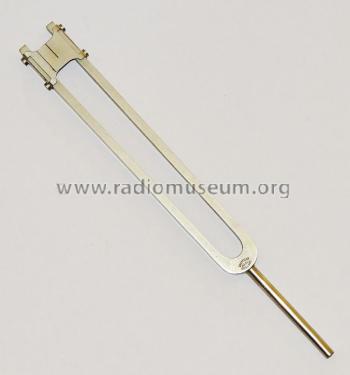Stroboscopic tuning fork
Ragg Tuning Forks; Sheffield
- Country
- Great Britain (UK)
- Manufacturer / Brand
- Ragg Tuning Forks; Sheffield
- Year
- 1931 ??
- Category
- Service- or Lab Equipment
- Radiomuseum.org ID
- 304039
- Power type and voltage
- No Power needed
- Material
- Various materials
- from Radiomuseum.org
- Model: Stroboscopic tuning fork - Ragg Tuning Forks; Sheffield
- Dimensions (WHD)
- 290 x 43 x 22 mm / 11.4 x 1.7 x 0.9 inch
- Notes
-
Electromechanical teleprinters, reperforators and paper tape readers that were driven by governed DC motors normally had stroboscopic target markings on the governor case to allow their speed to be set. For example, a motor that should run at 3000 rpm may have a governor marked with 5 white and 5 black segments, so that it should appear stationary when viewed at 250 Hz.
The calibration can be achieved simply by a 125 Hz tuning fork with overlapping slit shutters on the tines, through which the rotating governor can be viewed. Typically the governor is adjusted so that the motor is running slightly fast when idling, and slightly slow on full load, so that under normal operating conditions the speed is just right.
While the industry standard in Europe was 125 Hz, stroboscopic tuning forks were also made for 87.6 Hz, 120 Hz, 123.5 Hz, 140 Hz and 180 Hz. Steel tuning forks have a negative temperature coefficient and are normally calibrated at 20 deg C.
- Net weight (2.2 lb = 1 kg)
- 0.3 kg / 0 lb 10.6 oz (0.661 lb)
- Author
- Model page created by Bruce Taylor. See "Data change" for further contributors.
- Other Models
-
Here you find 1 models, 1 with images and 0 with schematics for wireless sets etc. In French: TSF for Télégraphie sans fil.
All listed radios etc. from Ragg Tuning Forks; Sheffield
Collections
The model Stroboscopic tuning fork is part of the collections of the following members.



